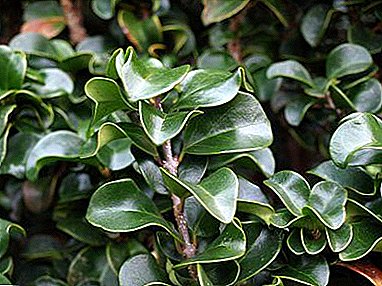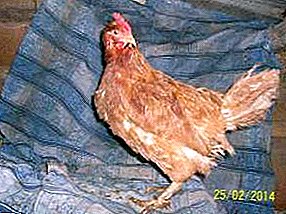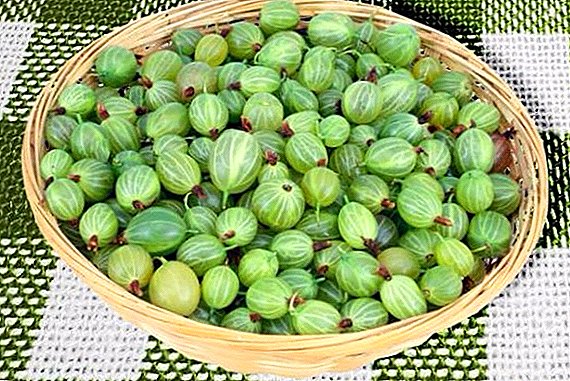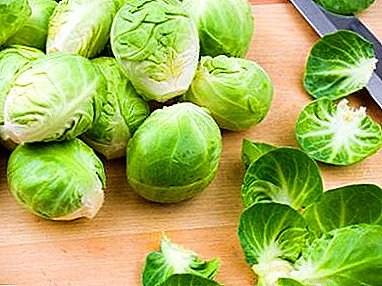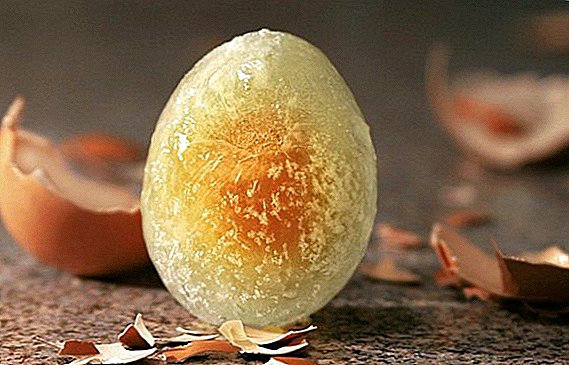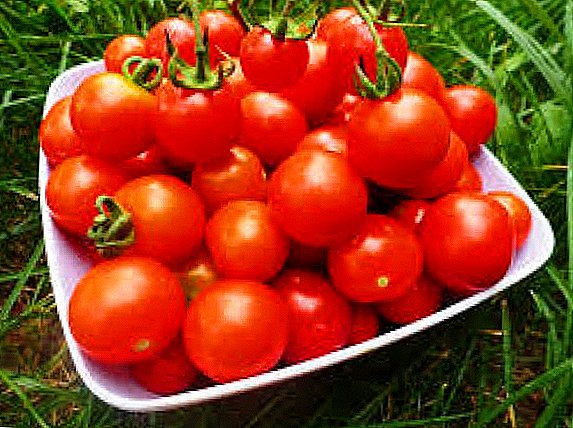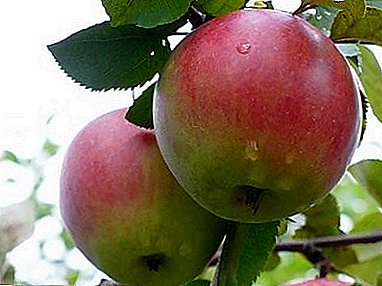
The Orlovskoye Polesye apple trees make it possible to enrich our winter ration with tasty and beautiful fruits with juicy, dense flesh.
Their ruddy "cheeks" look so attractive that not every private gardener will raise a hand to plant a crop of juice, jam, marshmallow or cider.
What kind is it?
Apple trees "Orlovskoye Polesie" - with beautiful fruits, winter hardy and fruitful representatives of the winter variety with its own immunity to the pathogen of scab.
Resistance to the main disease of culture provides the Vf gene. The variety is partially self-pollinating, resistant to the preservation of hereditary traits.
For four years, the variety was tested in the conditions of the Central, Nizhnevolzhsky, Chernozem areas. Registered in the database of the State Register since 2002.
Storage

Orlovskoye Polesye variety apples have good keeping quality.
The shelf life of the fruit can be extended until January, if they are immediately transported to specialized refrigerating chambers with a humidity control mechanism after removal.
The following varieties also possess good keeping quality: Chudny, Malt Bagaevsky, Kandil Orlovsky, Moscow Late and Young Naturalist.
Container for placing apples inside the cooling stations:
- plastic with ventilation holes throughout the entire area of the container,
- wooden (from non-coniferous varieties of wood).
Variety description Orlovskoye Polesye
Typical characteristics for adult trees:
- average tree height
- non-crowned crown
- an array of branches has a spherical shape.
The location of the main branches relative to the trunk is almost perpendicular. The branches are straight, shoots are directed upwards. The bark is smooth, on the trunk and lignified shoots of a warm gray color.
Fruits are tied on simple and complex annuli.
Growing brownish shoots slightly pubescent, take an arched shape, brown in cross section. The conical shape of a small size buds adjacent to the shoots.

Dark green with bluish tint the leaves are egg-shaped.
Melkopilchatye along the edge, with a wrinkled surface rough to the touch, attached to the branches with pubescent short petioles.
In one place develops several ovaries on small stalks. At the beginning of pinkish, they gradually brighten to pale pink.
Opened flowers are flat, with loosely rounded petals.
Anthers are lower than stigmas, pistils column fused, not trimmed.
Ripened fruits are shiny, large, oblong-conical shape. The bulk of apples ready for harvesting weighs 130-140 g each. Widely ribbed, with a medium sharply conical narrowed funnel and a closed cup. Furrowed saucer has a small size.
Seeds are brown, located in closed chambers.
The apple is held on a tree on a small stalk. In the stage of maturity, the rind of the fruit is shiny, slightly oily. The color is greenish-yellow with a blush spread to half of the fruit from merging reddish or pinkish-white stripes and light specks.
In the color of the pulp is clearly traced creamy tint. Taste sweet, sweet and sour.
Such varieties are demonstrated by the varieties Molodyozhny, Aromatny, Silver Hoof, Belfleur-Kitaika and Bolotovsky.
Fruit juiciness is high. According to the five-point system, the taste qualities of Orlovskoye Polesye apples received an estimate of 4.3.
Chemical characteristics of the fruit:
- Sugar content: 8.2%.
- Trapped acids: 0.78%.
- Ascorbic: 7.9 mg.
- P-active substances: 342 mg.
A photo
Photos of fruit varieties of apple "Orlovskoye Polesie":



Breeding history
For the first time, seedlings of Orlovsky Polesie were grown in 1979, by sowing seeds of the previous year's fruit from the mother tree 814, which was subjected to free pollination, in the ground.
Fruiting first copies of the new variety came 11 years later - in 1990. The work on growing Orlovsky Polesie was performed by: V.V. Zhdanov, E.N. Sedov, E.A. Dolmatov, Z.M.Serova.
Growing region
Focuses on the climatic conditions of the Central Black Earth region of Russia. Extremely rarely suffers from frost, resistance to winter low temperatures is similar to that of Antonovka ordinary.
In this region, the veteran, Kandil Orlovsky, Orlik varieties performed well.
Yield

Mass ripeness of the harvest falls in the middle and second half of September.
Young trees begin to bear fruit well from the eighth year that has passed after re-grafting.
Average: up to 133-150 kg / ha, which at a density of 100 trees / ha is about 130-150 kg from one apple tree.
Planting and care
The variety requires sufficient light. The lack of "personal space" and shading leads to increased acidity in the fruit, reducing the volume of the crop.
Optimum soil acidity for culture: pH 5.6-6.0. If the indicator is clearly exceeded (the landmark is a well-growing sorrel, lush raspberries, velvety moss, horse sorrel), the place for planting an apple tree should be made less sour.
To do this, use:
- lime,
- dolomite flour,
- wood ash.
It is better to add the component to the ground six months before laying out an apple corner in the garden.
If a place for a tree is periodically flooded or ground water passes within the limits of 2-2.5 m, then it is not a landing pit that is being prepared for the seedling, but a mound of enriched bulk soil.
What should be the care to get the right crop?
Counting on good harvests in the future, planting seedlings, do not forget:
- leave the neck of a tree 5 cm above the ground;
- to cover the root with a wet rag, intending to transport the plant from the nursery to its site;
- remove all the buds from a tree that is blooming for the first time (this will help it to fully charge itself with moisture and nutrients on the eve of winter, to develop a healthy root system);
- to protect the trunk from sunburn with whitewash, and from rodents - with a special net, tying with straw, bark, reed (in winter);
- remove almost all foliage from the crown if the rhizome of the planting material is "bald";
- shorten the "hairstyle" by a third, which will facilitate and accelerate the development of the roots.
Support fertilizer and watering:
- Watering trees up to 5 times a month, in portions of 12-15 liters twice a day watering.
- It is better to carry out annual top dressing only on poor sandy soils, adding a mixture of urea, nitroammofoski, 30 g each, 5-7 kg of humus to the soil in the spring.
- More fertile areas enrich less.
Diseases and pests

Against leaf-eating and fruit moths use insecticides.
From the majority of transmitted diseases of apple trees, gardeners use periodic spraying of trees with copper sulphate or preparations based on it.
Thinning of the crown, is the prevention of the defeat of trees by a fungus (at a time not more than a quarter of the shoots scheduled for elimination are removed).
In order not to provoke shock from trimming:
- thinning is performed after abscission of foliage or a few weeks before the start of bud dissolution
- plots with remote branches and shoots covered with a pitch (or oil paint).
It will not prevent from time to time to apply preventive measures against pests of the garden, such as the codling moth, mining moth, hawthorn, silkworms and fruit sapwood.
Do you want to grow an apple tree that easily endures the vagaries of winter, is not afraid of scab, and every year pleases you with a good harvest?
Then plant the Orlovskoye Polesye apple seedling on your plot, a variety that has shown excellent results for decades with timely and proper agricultural technology.
With the defeat of the tree with black cancer, bacterial burn, it is best to immediately separate the affected branches from the rest of the crown array and burn.




